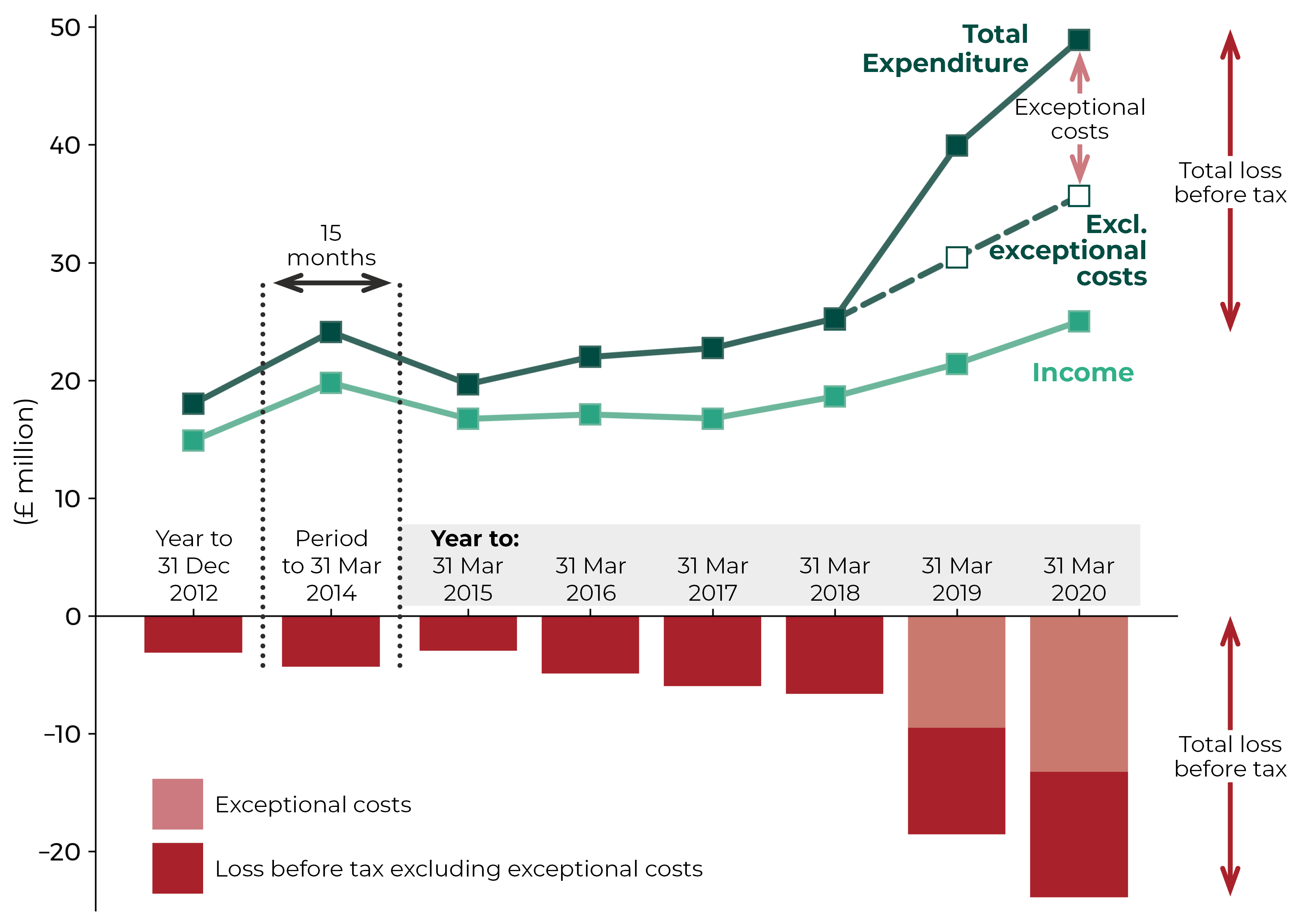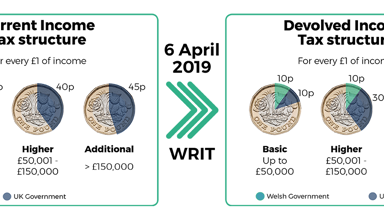Much has happened since we published a series of articles about Cardiff International Airport Limited (the Airport) in early March 2020. Most notably, the global pandemic which led to a halt on international travel for most people. In this article, we provide an update on the Airport’s performance and the financial assistance provided to it by the Welsh Government since it was bought in 2013.
How many passengers used the Airport in 2019-20?
After fluctuating in the early years of the Welsh Government’s ownership, passenger numbers increased year-on-year , reaching almost 1.6 million in 2018.
2019-20 bucked that trend with a marginal fall to 1.58 million passengers, a 0.4% decrease compared with the previous year. The Airport had expected an increase to 1.66 million passengers. However, it was a challenging year with two of the Airport’s operators, Thomas Cook and Flybe, ceasing trading. The implications of COVID-19 added to this during the final few weeks of that financial year, with travel restrictions from mid-March 2020.
What do the latest accounts show?
The Airport’s latest accounts (March 2021), report a pre-tax loss of £23.90m for 2019-20. This is £5m more of a loss than 2018-19. This continues a trend in its financial performance which has seen the Airport make a pre-tax loss for each period since the Welsh Government’s acquisition.
The graph below shows the Airport’s income, expenditure and pre-tax loss from 2012 to 2020.

The Airport continued to grow its income, generating almost £25m in 2019-20, almost £4m more than in 2018-19. However, the increase in the Airport’s expenditure continued to outpace its income.
Taken together, its expenditure (the cost of its sales, administrative expenses and the interest payable on its loans) increased by over £5m in 2019-20. Added to this was the cost of ‘exceptional items’, which are transactions that fall within the ordinary activities of the Airport but are presented separately in the accounts due to their size or incidence. These costs related to the elimination of the value of contract rights the Airport holds to provide certain services to other organisations (£13.25m). The Airport wrote off some of their value in 2018-19.
Pre-tax profit or loss is a measure of financial performance that takes account of all expenditure incurred by an organisation, including depreciation but excluding taxation.
The Airport uses a different indicator, ‘Earnings Before Interest Taxation Depreciation and Amortisation’ (or ‘EBITDA’), when it reports its financial performance. EBITDA adjusts profit to remove the impact of an organisation’s financing and accounting decisions, such as depreciation and taxation. It is seen as a measure of an organisation’s operating performance and is widely reported by companies, including some airports.
In 2019-20, the Airport’s EBITDA was negative £691,000 (excluding exceptional items). This compares with a positive EBITDA of £77,000 for 2018-19, which the Airport reported was “the first time a positive result has been posted in eight years”.
How has the pandemic affected the Airport?
Significantly - the Airport did not operate commercial flights from 27 March 2020July 2020. As a result of this and subsequent travel restrictions, passenger numbers in 2020 were just under 220,000, a decrease of 87% on 2019. The Civil Aviation Authority (CAA) reported this to be the largest decline in any UK airport.
The airfield remained open during the pandemic. The Airport “supported essential business flying, medical flights for the NHS, and also training flights”. It also supported freight and logistics, including the delivery of PPE for the NHS in Wales.
With its terminal closed, the Airport had been “working hard to reduce costs as much as possible and generate new sources of revenue”. It reduced its staff to the “absolute minimum needed”, using the UK Government’s Job Retention Scheme with “just over half of the airport team in and out of furlough” from 6 April 2020. It also contracted out staff to support local authorities’ test and trace facilities and some firefighters provided cover at the Dragon’s Heart hospital at the Principality Stadium.
The Airport said it needs support while the industry recovers so it can maintain its “critical national infrastructure and economic role” within Wales.
Welsh Government financial assistance
In April 2020, the previous Welsh Government announced short-term funding for the Airport. This was followed in March 2021 with a financial support package “against a five year plan for the rescue and restructure of the airport”, with the aim to bring it “back to financial viability" in around the next six years (by 2025/26).
This package included a grant of up to £42.6m aimed at enabling the Airport to “restructure its operations, and secure its long term viability”. This would be provided over four years, with £16 million awarded in the first year (2021-22).
The Welsh Government also wrote off £42.6 million of the loan it had given the Airport, leaving it to repay £26.3 million by 2045, saying:
This decision maximises the likelihood of recovery of Welsh Government loan investment and delivers the lowest lifetime cost option. It provides the best way forward for the Welsh Ministers as sole shareholders of the airport from a commercial perspective.
Finally, the Welsh Government said that, as a result of the pandemic, the Airport now had “a £15m liquidated market value for all of the assets of the business on a break up basis”. This wiped £46.3m off the value of its investment.
The Welsh Government’s investment in, and loans to, the Airport are shown in the timeline below.
Key:
| Investments and shares | |
| Commercial loans |
March 2013: £52m
Purchased the Airport
March 2013: £3.3m
Cash investment - later converted to shares
November 2013: £10m
For capital expenditure
November 2014: £13m
For route development
March 2017: £15m
Revised loan agreement, which consolidated the debt and made additional funds available (new total £38.2m)
March 2018: £6m
Additional shares purchased
October 2019: £21.2m
Refinanced previous loan facility and provided additional funds.
February 2020
Welsh Government reports the Airport requested £28m but only the first two years at a value of £21.2m had been approved.
April 2020: £4.8m
Short-term funding agreed to "support its reduced operations and to maintain solvency".
February 2021: £71.6m
Welsh Government confirms the total value of the loan at the time of the new agreement (Sept 2019). It includes the loan principal of £59.4m (comprising £38.2m - March 2017; and £21.2m - October 2019), accrued interest (£5.4m) and the amount sought by the Airport not yet approved by Welsh Government (£6.8m).
The letter notes "the most recent financial support announced for Cardiff Airport was a separate emergency loan facility for the sum of £4.8m to support the Airport through the pandemic".
March 2021
Total cost of the investment to date:
£61.3m
Impact of the pandemic on the Welsh Government valuation of its investment:
-£46.3m
Revised value of the Welsh Government's investment:
£15m
March 2021
The amount owed by the Airport against the loan agreements (£71.6m + £4.8m):
£68.9m
Welsh Government debt write off:
-£42.6m
£26.3m
Green shoots of recovery?
In December 2020, Wizz Air announced it would set up a new base in Cardiff. Some airlines also unveiled plans for new routes – from Cardiff to Dublin, Belfast, and Edinburgh. While this was good news for the Airport, Stobart Air – the operator of the planned new routes to Dublin and Belfast – then ceased trading on 11 June 2021.
In terms of easing restrictions, the Welsh Government announced that international travel would be permitted from 17 May 2021 for people living in Wales.
Travellers arriving in Wales from within the UK (England, Scotland or Northern Ireland) and the Common Travel Area (the UK, the Channel Islands, the Isle of Man and Republic of Ireland) who have not been outside the Common Travel Area in the 10 days before entering Wales do not need to isolate, nor provide their journey and contact details.
In common with other parts of the UK, the Welsh Government introduced a traffic light system for people arriving in Wales from other countries.
What does this mean for the Airport and its recovery?
On 24 June 2021, the Welsh Government announced changes to its international travel restrictions, adding more countries and territories to the green list. These included destinations to which the Airport reported passengers in 2019-20, such as Barbados, the Balearic Islands and Malta. However, some of its most popular destinations or flights remain on the amber list [accessed 28 June 2021] , including the Greek Islands), the Netherlands, mainland Spain and the Canary Islands.
As well as the rules for foreign travel to and from Wales, passengers need to consult the requirements for visitors for the county or territory to which they wish to travel or transit through. These may have a potential impact on passenger numbers.
The message from the Minister for Health and Social Services has been “this is the year to holiday at home”. In making the recent announcement about changes to the restrictions, she said the Welsh Government’s “strong advice continues to be not to travel overseas unless it is essential”.
Given the Welsh Government’s steer, it remains to be seen what the current lifting of restrictions means for the Airport and the delivery of its rescue and restructure plan.
Article by Joanne McCarthy and Joe Wilkes, Senedd Research, Welsh Parliament






